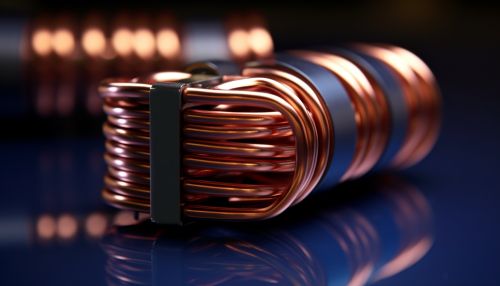Inductor
Introduction
An inductor is a passive electronic component that stores energy in its magnetic field. It is one of the basic components used in electronics where current and voltage change with time, due to the ability of inductors to delay and reshape alternating currents.


Principle of Operation
The operation of an inductor is based on Faraday's law, which states that the voltage across an inductor is directly proportional to the rate of change of current through it. This property is known as inductance and is denoted by the symbol 'L'. The unit of inductance is the Henry (H).
Types of Inductors
Inductors come in various types, each designed for specific applications. Some of the common types include:
- Air Core Inductor: These are inductors that use air as the magnetic core. They have low inductance and are used in high-frequency applications.
- Ferrite Core Inductor: These inductors use a ferrite core, which increases the inductance and helps to reduce high-frequency noise.
- Iron Core Inductor: These inductors use an iron core, which provides high inductance but can cause losses at high frequencies.
- Toroidal Core Inductor: These inductors have a toroidal (doughnut-shaped) core, which provides high inductance and low magnetic leakage.
Applications of Inductors
Inductors are used in a wide range of applications, including:
- Power Supplies: Inductors are used in power supplies to convert AC voltage to DC voltage. They are also used in switched-mode power supplies to store energy and smooth out the voltage.
- Radio and Television: Inductors are used in the tuning circuits of radios and televisions to select the desired frequency.
- Telecommunication: Inductors are used in telecommunication for impedance matching, signal processing, and noise filtering.
- Automotive: Inductors are used in automotive electronics for power management and noise suppression.
Inductor Parameters
The performance of an inductor is characterized by several parameters, including:
- Inductance (L): This is the primary parameter of an inductor. It measures the ability of the inductor to store energy.
- Quality Factor (Q): This parameter measures the efficiency of the inductor. A high Q factor indicates low energy loss.
- Self-Resonant Frequency (SRF): This is the frequency at which the inductor's inductive reactance equals its capacitive reactance.
- DC Resistance (DCR): This is the resistance of the inductor's wire to direct current (DC).
Conclusion
Inductors play a crucial role in many electronic devices and systems. Their ability to store energy and delay and reshape currents makes them indispensable in a wide range of applications, from power supplies to telecommunications.
